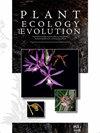A striking new species of Rhipidocladum (Poaceae: Bambusoideae: Bambuseae: Arthrostylidiinae) with single, terminal-spikelet synflorescences, endemic to Jalisco, Mexico
IF 1.1
4区 生物学
Q3 PLANT SCIENCES
引用次数: 3
Abstract
Background and aims – Rhipidocladum, a woody bamboo genus distributed from Mexico to Argentina, has raceme like synflorescences of multiple spikelets. Six of the 21 known species occur in Mexico. In this study, we present a full description, distribution map, illustrations, and photographs of an unusual new Rhipidocladum species endemic to Jalisco, Mexico. Additionally, we provide an updated key to the species of Rhipidocladum in Mexico. Material and methods – This study was based on fieldwork, literature, and herbarium specimens review. Specimens collected were analysed and photographed during fieldwork. The conservation assessment is based on spatial analyses, following the IUCN guidelines and criteria. Results – This is the first species in the genus Rhipidocladum that has synflorescences with only a single, terminal spikelet. Rhipidocladum singuliflorum occurs only in three localities in the municipality of Puerto Vallarta, Jalisco, Mexico. This species inhabits the canyon slopes of rivers in subdeciduous and tropical dry forests, at 6–150 m a.s.l. According to our IUCN assessment, this new species should be considered Critically Endangered.竹科:竹科:节肢竹科)一种具有单,顶生小穗同花的引人注目的新种,产于墨西哥哈利斯科
背景和目的:毛竹属,一个分布于墨西哥到阿根廷的木本竹属,具有多个小穗的总状花序状同花序。已知的21种中有6种产于墨西哥。在这项研究中,我们提供了一个完整的描述,分布图,插图和照片的一个不寻常的新物种,在哈利斯科州,墨西哥特有。此外,我们还提供了一份更新的墨西哥棘齿纲物种的检索表。材料和方法:本研究基于实地考察、文献和植物标本馆标本回顾。在野外工作中对采集的标本进行了分析和拍照。保护评估是基于空间分析,遵循世界自然保护联盟的指导方针和标准。结果:本属属中首次发现同花花序仅有一个顶生小穗。单花蓟马只生长在墨西哥哈利斯科州巴亚尔塔港市的三个地方。该物种栖息在海拔6-150米的热带干燥森林和亚热带落叶森林的河流峡谷斜坡上。根据IUCN的评估,该新物种应被视为极度濒危物种。
本文章由计算机程序翻译,如有差异,请以英文原文为准。
求助全文
约1分钟内获得全文
求助全文
来源期刊

Plant Ecology and Evolution
PLANT SCIENCES-
CiteScore
2.20
自引率
9.10%
发文量
27
审稿时长
>12 weeks
期刊介绍:
Plant Ecology and Evolution is an international peer-reviewed journal devoted to ecology, phylogenetics and systematics of all ‘plant’ groups in the traditional sense (including algae, cyanobacteria, fungi, myxomycetes), also covering related fields.
The journal is published by Meise Botanic Garden and the Royal Botanical Society of Belgium.
 求助内容:
求助内容: 应助结果提醒方式:
应助结果提醒方式:


